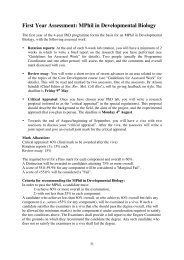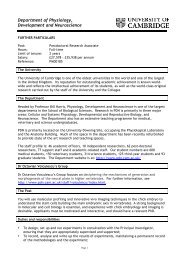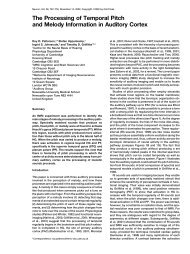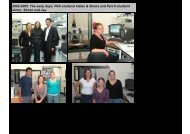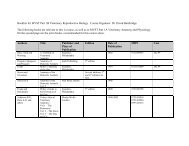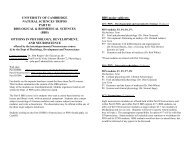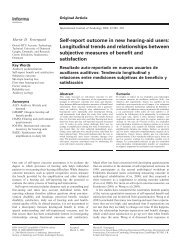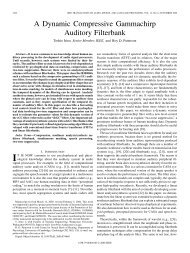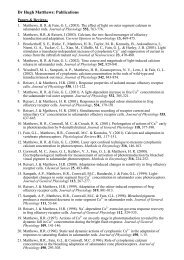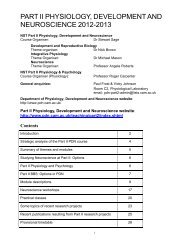FRIDAY MORNING, 20 MAY 2005 REGENCY E, 8:30 A.M. TO 12:00 ...
FRIDAY MORNING, 20 MAY 2005 REGENCY E, 8:30 A.M. TO 12:00 ...
FRIDAY MORNING, 20 MAY 2005 REGENCY E, 8:30 A.M. TO 12:00 ...
Create successful ePaper yourself
Turn your PDF publications into a flip-book with our unique Google optimized e-Paper software.
5aSC14. Spectral contributions to intelligibility of sentences with<br />
flattened fundamental frequency. Peter J. Watson and Robert S.<br />
Schlauch Dept. of Speech-Lang.-Hearing Sci., Univ. of Minnesota, 164<br />
Pillsbury Dr. S.E., Shevlin 115, Minneapolis, MN 55455, pjwatson@<br />
umn.edu<br />
Recently, the contribution of fundamental frequency (F0) variation to<br />
speech intelligibility in background noise has been studied J. Laures and<br />
G. Weismer, JSLHR 42, 1148–1156 1999. The process used for this<br />
analysis is to flatten the frequency contour at the average F0. Results<br />
show that sentences with flattened F0 are less intelligible than those with<br />
natural F0 variation. However, this technique may reduce the prominence<br />
of formant peaks because it excludes F0s that are below the average<br />
flattened frequency. As noted by Laures and Weismer 1999, eliminating<br />
lower F0s from the analysis results in wider spacing between the harmonics<br />
and the available energy to excite the vocal tract resonances is diminished.<br />
This study examined the effect of flattening at the average and<br />
lowest F0 of each sentence to intelligibility. Twenty subjects listened to<br />
sentences in a continuous noise background. Sentences were equated for<br />
root-mean square energy. Results showed that the low-flattened condition<br />
was significantly more intelligible than the average-flattened condition.<br />
However, a condition with natural F0 variation was more intelligible than<br />
the two flattened conditions. These findings show that that the frequency<br />
of flattening does contribute to intelligibility but that natural F0 variation<br />
appears to contribute to a greater degree.<br />
5aSC15. Comparison of cues in auditory selective and divided<br />
attention. Jae hee Lee and Larry E. Humes Indiana Univ. at<br />
Bloomington, Bloomington, IN 47405<br />
This study investigated auditory selective and divided attention in ten<br />
normal-hearing listeners. Subjects listened to two simultaneous sentencelike<br />
utterances from the Coordinate Response Measure CRM speech<br />
corpus at 90 dB SPL in dichotic or monotic listening conditions. This<br />
corpus has the following format, Ready call sign, gotocolor number,<br />
now, with all possible combinations of call signs 8, colors 4 and numbers<br />
8. In all conditions, the listener identified the color-number coordinates<br />
spoken by the target talker. The target talker was identified by a cue<br />
provided either prior to selective attention or following divided attention<br />
the presentation of the two simultaneous utterances. In the first experiment,<br />
either the ear or the call sign served as the cue for the target<br />
talker in monotic or dichotic listening conditions. In the second experiment,<br />
talker gender served as the cue in monotic listening conditions.<br />
Across both experiments, performance for selective attention was superior<br />
to that for divided attention. Performance for ear or gender cueing was<br />
better than for call sign. Analysis showed that 80% of errors were due to<br />
intrusions from the competing utterance, supporting an informational attention,<br />
rather than energetic, form of masking. Work supported, in part,<br />
by NIH R01 AG08293.<br />
5aSC16. Effects of high intensity on recognition of low- and highfrequency<br />
speech in noise. Van Summers and Mary Cord Army<br />
Audiol. & Speech Ctr., Walter Reed Army Medical Ctr., Washington, DC<br />
<strong>20</strong><strong>30</strong>7-5<strong>00</strong>1<br />
For listeners with normal hearing NH, speech recognition scores often<br />
decrease when intensities exceed moderate levels rollover is observed.<br />
It is currently unclear whether the factors leading to rollover in<br />
NH listeners also limit performance for hearing-impaired HI listeners at<br />
high sound levels. This study aimed at clarifying the stimulus conditions<br />
most clearly associated with rollover and whether rollover effects are similar<br />
for NH listeners and listeners with mild hearing impairment. In Stage<br />
1, NH and HI listeners heard digitally-filtered sentences and adaptive procedures<br />
were used to determine high- and low-frequency bandwidths<br />
yielding 70%-correct word recognition in quiet at moderate levels. In<br />
Stage 2, broadband and band-limited stimuli based on the high-, and<br />
low-frequency passbands measured in quiet in Stage 1 were tested at<br />
moderate levels in background noise. Noise levels were varied adaptively<br />
to determine signal-to-noise levels supporting <strong>30</strong>%-correct recognition.<br />
Stimulus conditions leading to criterion performance at moderate presentation<br />
levels in Stage 2 were then retested at higher levels in Stage 3. NH<br />
listeners showed larger and more consistent rollover effects for highfrequency<br />
than for low-frequency or broadband stimuli. The results for HI<br />
listeners showed greater variability but also indicated clear rollover effects<br />
for high-frequency stimuli at high levels.<br />
5aSC17. The effect of auditory feedback alterations on the speech<br />
quality of hearing aid and cochlear implant users. Dragana Barac-<br />
Cikoja and Leslie Klein Gallaudet Univ., 8<strong>00</strong> Florida Ave. NE,<br />
Washington, DC <strong>20</strong><strong>00</strong>2<br />
The speech of seven hearing aid HA users with severe-profound<br />
hearing loss and six cochlear implant CI users was recorded as they read<br />
the Rainbow Passage while their speech feedback was either spectrally<br />
altered in real-time, completely masked by multi-talker babble noise, or<br />
unaltered. Spectral alterations were implemented by filtering the speech<br />
signal into either one or four frequency bands, extracting their respective<br />
amplitude envelopes, and amplitude-modulating the corresponding noise<br />
bands. While the single-band condition provided only coarse information<br />
about the speech rhythmic structure, the four-band noise signal remained<br />
intelligible. Auditory feedback was presented via insert earphones to the<br />
HA users, and via the auxiliary jack with the headpiece microphone silenced<br />
to the CI users, at the participants’ most comfortable listening<br />
level. The quality of the recorded speech separated into individual sentences<br />
was assessed using a 2IFC procedure. For each combination of the<br />
experimental conditions, six judges selected the more natural-sounding<br />
utterance in a pair. Preference scores were calculated for each of the four<br />
feedback conditions and statistically tested. HA and CI group differed in<br />
how feedback intelligibility affected the speech quality. Possible acoustic<br />
correlates of the perceived differences will be discussed.<br />
5aSC18. Articulatory and acoustic measurements of vowels in hearing<br />
impaired speakers following treatment. Penelope Bacsfalvi and<br />
Barbara Bernhardt School of Audiol. and Speech Sci. SASS, UBC,<br />
Vancouver, BC, Canada V6T 1Z3, Penelope@audiospeech.ubc.ca<br />
The purpose of this study was to examine the relationships between<br />
ultrasound tongue shapes, electropalatography EPG contacts, formant<br />
data, and the perceptual data in the vowels of three hard of hearing adolescents.<br />
This pilot study examines the pre- and post-therapy speech of the<br />
participants in a 6 week group therapy programme with ultrasound and<br />
EPG technologies. Before treatment, participants showed particular difficulty<br />
with high vowels and the tense-lax distinction. Recordings were<br />
made of 2 males and 1 female with ultrasound and EPG. Three types of<br />
measurements were made; formant measurements, EPG tongue palate<br />
contacts, and perceptual judgements by experienced speech-language pathology<br />
researchers. Initial analysis values showed a change in the direction<br />
of EPG contact patterns, and perceptual categories. F1 values decreased<br />
and F2 values increased, moving in the direction of typical<br />
formant frequencies found in hearing people. Preliminary results of this<br />
study support a lingual-articulatory approach to treatment.<br />
5aSC19. The role of fundamental frequency „F0… contours in the<br />
perception of speech against interfering speech. Christine Binns and<br />
John F Culling School of Psych., Cardiff Univ., Tower Bldg., Park Pl.<br />
Cardiff, CF10 3AT, UK<br />
A set of experiments investigated the effect of the F0 contour on<br />
speech intelligibility against interfering sounds. Speech Reception Thresholds<br />
SRTs were measured in dB for sentences with different manipulations<br />
of their F0 contours. These manipulations involved either a scaled<br />
reduction in F0 variation, or the complete inversion of the F0 contour.<br />
Against speech-shaped noise, a flattened F0 contour did not have a sig-<br />
2606 J. Acoust. Soc. Am., Vol. 117, No. 4, Pt. 2, April <strong>20</strong>05 149th Meeting: Acoustical Society of America 2606



